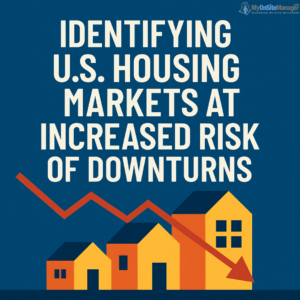The U.S. housing market has experienced rapid price growth in recent years, fueled by low interest rates, high demand, and a competitive real estate environment. However, as economic conditions shift, some housing markets are showing signs of increased risk for a downturn. Recent data highlights specific regions that may be more vulnerable due to affordability concerns, high foreclosure rates, and rising unemployment.
Housing Affordability Reaches Critical Levels
One of the most pressing challenges in today’s housing market is affordability. According to a report from real estate data provider Attom, over one-third of local wages are now required, on average, to cover housing payments in the U.S. This surpasses traditional affordability thresholds, making homeownership increasingly difficult for many Americans.
As home prices have surged, wages have not kept pace, leaving many prospective buyers priced out of the market. In addition, rising mortgage rates have further strained affordability, making monthly payments more expensive. When affordability issues become widespread, housing demand can slow, increasing the risk of price corrections in affected markets.
Most At-Risk Housing Markets Identified
Attom’s study analyzed factors such as home price trends, affordability, foreclosure rates, and unemployment data to determine which areas are at the highest risk of a downturn. The findings pinpointed 50 counties across the U.S. that are particularly vulnerable, with the highest concentration of at-risk markets in five states:
- California: 14 counties at risk
- Florida: 7 counties at risk
- Illinois (Chicago metro area): 5 counties at risk
- New York City metro region (including parts of New Jersey): 4 counties at risk
These states have historically seen strong housing markets, but rising costs, economic shifts, and mortgage burdens are making them increasingly susceptible to declines in home values and potential increases in foreclosure activity.
Why These Markets Are Vulnerable
Several factors contribute to the increased risk in these regions:
1. High Home Prices and Cost Burdens
Markets in California, Florida, and New York are known for their high property values, but with the recent surge in prices, fewer people can afford to buy. This leads to reduced demand and a potential slowdown in home price growth.
2. Rising Foreclosure Rates
Some of these markets are already seeing an uptick in foreclosures, a sign of financial distress among homeowners. High foreclosure rates can indicate that homeowners are struggling with mortgage payments, especially in an environment with higher interest rates.
3. Economic and Employment Factors
Unemployment levels can play a significant role in housing stability. Areas with rising job losses or economic slowdowns may see higher foreclosure rates and declining home prices as residents face financial strain.
4. Interest Rate Pressures
The Federal Reserve’s decision to raise interest rates in an effort to curb inflation has made borrowing more expensive. Homebuyers are now facing significantly higher mortgage rates compared to a few years ago, reducing their purchasing power and leading to weaker demand in expensive markets.
What This Means for Homebuyers and Investors
While these findings do not necessarily indicate an immediate crisis, they serve as a warning sign for potential market adjustments. Here’s what homeowners, buyers, and investors should consider:
-
For Homebuyers: If you’re looking to buy in one of these at-risk markets, it’s essential to evaluate long-term affordability and potential price stability before making a purchase. Be mindful of rising mortgage rates and ensure you’re financially prepared for homeownership.
-
For Homeowners: If you own property in one of these areas, now might be a good time to assess your home equity, refinance if possible, or prepare for market fluctuations. Home values could stagnate or decline in the near future.
-
For Real Estate Investors: Investors should carefully analyze market trends before making new acquisitions in these vulnerable regions. While downturns can present buying opportunities, they also pose risks in terms of property value declines and rental market stability.
Looking Ahead: Market Stability vs. Market Risk
The housing market remains dynamic, and while these at-risk regions face pressure, the overall U.S. housing market is not necessarily heading for a nationwide collapse. Housing markets tend to be highly localized, meaning some areas may experience declines while others continue to see growth.
Rob Barber, CEO of Attom, emphasizes that these findings are not definitive predictions of a crisis but rather indicators of areas experiencing pressures that could influence home values, foreclosure rates, or homeowner equity. Policymakers, real estate professionals, and homeowners alike should monitor these trends closely to navigate the evolving landscape.
Final Thoughts
Housing markets across the U.S. are facing increasing economic pressures, and some regions are more vulnerable than others. Whether you’re a homeowner, a potential buyer, or an investor, understanding these risks can help you make informed decisions. As economic conditions evolve, staying updated on market trends and affordability metrics will be key to navigating the real estate landscape in 2025 and beyond.
Source: National Mortgage News – Housing Markets at Risk of Downturn

